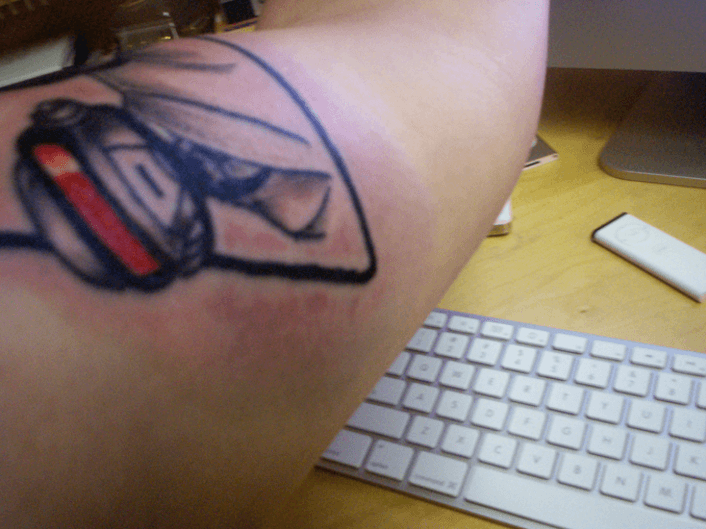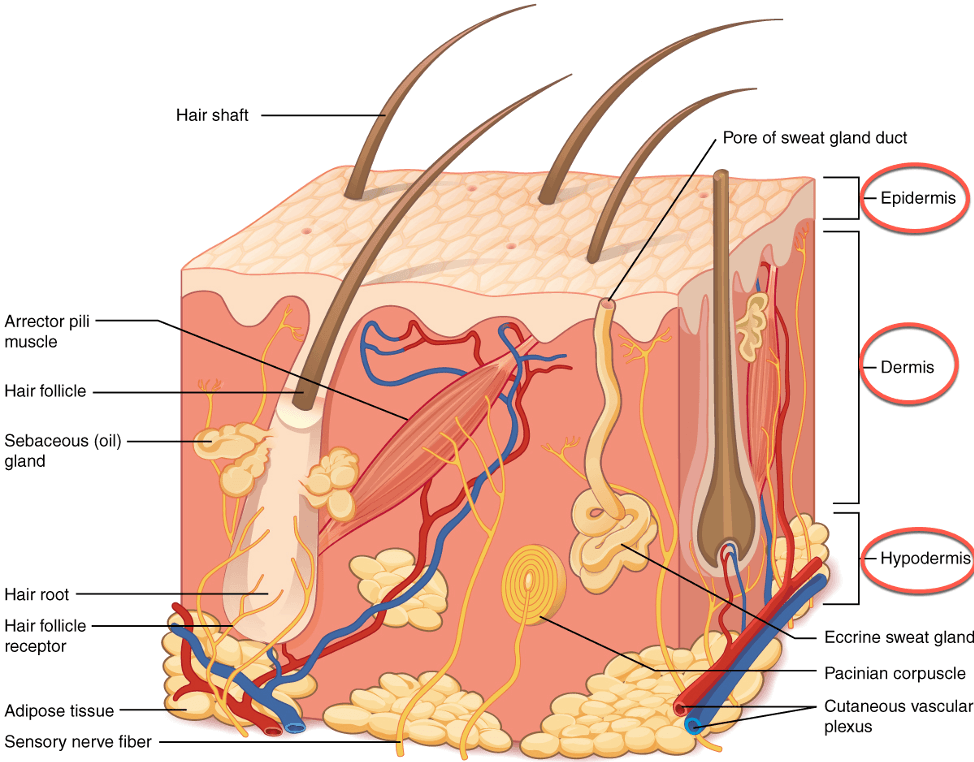If it’s your first time getting inked and you suddenly see a bruise developing around the tattoo, you may immediately think that something’s wrong… perhaps, the wound’s infected or you’ve got an allergic reaction going on. This may be the case, but more often than not, it’s nothing more than a normal after-effect of getting tattooed. Scroll down to find out why new tattoo bruising happens all the time!
Page Contents
Why do new tattoos bruise?

The bruising on this tattoo looks bad. Hopefully, it didn’t last too long. (Photo by Nikki on Flickr)
Not all tattoos actually bruise, but it’s not all that uncommon either. As you can see in the picture above, the upper arm tattoo is bruised quite badly. You can see the red, swollen area in and around the tattoo – that looks really painful, doesn’t it?!
But don’t worry, most bruises disappear within a week or so. It’s usually nothing to get freaked out about. Tattoo bruising is normally harmless and won’t do any lasting damage to your precious tattoo.
So, why do new tattoos bruise?
You know that during the tattooing process, needles pierce the skin so that ink is deposited in the dermis layer. Unlike the topmost layers of skin, the dermis doesn’t shed, so it’s possible for tattoo ink to stay there forever.
Here’s a graphic of the different layers of skin:

Now, the thing with the dermis is that it houses a lot of structures, like hair follicles, sweat glands, oil glands, blood capillaries, and more. When needles penetrate the dermis, it tends to hit a lot of these tiny capillaries which then causes red blood cells to leak out. Some blood cells go up and exit the skin, others pool into the surrounding tissue.
The blood on the surface dries up relatively quickly, however, underneath it’s a different story. The internal bleeding goes on for a bit longer and the volume of blood will depend on the number of capillaries broken by the needles.
Initially, the bruising will appear reddish in colour. But pretty soon, the tiny space becomes cramped and oxygen starts running out. This turns the red blood cells into a blue colour (hence why you see bruises turning bluish after some time).
The body then breaks down the leaked blood cells and eventually absorbs them back into the body (and skin colour returns to normal). This entire process occurs over a period of several days (usually up to a week or more).
Confused? Here’s an easy to understand video from Operation Ouch:
Why are brand-new tattoos prone to bruising?
Not everyone’s going to bruise after getting a new tattoo, but a lot of people will. Here are the most common reasons why many experience tattoo bruising:
- The tattooist’s skill and technique
A tattooist – who has worked on his craft for several years – will have a much more refined technique than his less experienced peers. They’ll know how to position their tattoo machine properly, so it doesn’t inflict unnecessary damage to the skin. No tattooist is perfect, of course, but experienced ones will know not to put too much pressure on the skin to reduce capillary damage.
- Some people are naturally prone to bruising
You’d know yourself if you bruise easily. If you do, then chances are you’re also going to bruise when you get tattooed. People who have underlying medical conditions such as iron deficiency anaemia, diabetes, leukaemia, haemophilia, and malnutrition, bruise more easily than others who don’t have these conditions.
- Tattoo location
Some parts of the body are relatively quick to bruise. For some people, they tend to bruise faster in fatty areas. So, for instance, if you decide to get tattooed on your buttocks, then you may experience bruising. For others, they tend to bruise easily over less fatty spots. If they get tattooed on their wrist and ankles, for example, then they’d bruise easily, too.
Related article: Tattoo Pain Chart: How Bad Do Tattoos Hurt?
- Taking blood thinning medication
If you’re taking medication that can thin blood (like aspirin), then chances are you’ll bruise right after your tattoo session. These medicines are useful for preventing life-threatening blood clots, but when it comes to tattoos, it can cause lots of issues. For instance, aspirin can make you more susceptible to bruising and a slower tattoo healing process.
Related article: Can You Get A Tattoo While On Antibiotics?
- Early sign of tattoo infection
A bruising alone is not necessarily a sign of infection. But if you’re experiencing other symptoms as well like pain, swelling, fever, bad smell, and/or pus, then you’ve got a problem on your hands.
Related article: Infected Tattoo 101: Causes, Symptoms and Treatment Options
What’s the cure or remedy for tattoo bruising?
Treating a bruised tattoo is different from treating a normal bruise. This is because a fresh, healing tattoo is technically an open wound, so you need to be extra careful.
That said, these are some suitable treatment options for a bruised, healing tattoo:
- Elevate bruised area

Elevate the bruise (Photo by Sereja Ris)
When more blood pools to the bruised area, it can cause even more swelling. Elevating the bruise helps reduce the blood flow to the area, thus speeding up the tattoo healing process.
What you need to do is to raise the affected area above the heart. So, if you’ve got a tattoo on the lower part of your body, you can lie down and put some pillows underneath your buttocks to raise your lower extremities. You can do this whilst you sleep or rest throughout the day.
- Take lots of rest
The more your body gets to rest, the faster your tattoo is going to heal up. Now, if you got tattooed on an often-used body part like your hands, then you need to lay off a bit. Also, depending on where you got inked, you may need to think outside the box to avoid working the area so much.
Rest includes avoiding exercise, at least for the first few days or so. You don’t want to overwork your body. And your heart will have to pump harder to supply blood throughout the body (which can worsen the bruising).
- Apply ice
For normal bruises, you can apply ice or a cold compress directly to the spot. But for healing tattoos, you need to apply a barrier cloth between the ice and skin to prevent bacteria from infecting the tattoo. This method helps restrict blood flow and prevents blood from leaking too much into the surrounding tissue.
- Take some ibuprofen
If you find the bruising painful and it’s affecting your daily activities, then taking some ibuprofen may help reduce the pain and swelling. It will also help the tattoo bruise to disappear faster.
- Stop smoking
Smoking has a lot of well-documented ill effects on the body. When it comes to bruising, healing tattoos, smoking can delay tissue repair and decrease blood supply. Obviously, not ideal for a healing tattoo. So, skip the cigarettes a week before tattooing and a couple of weeks after getting inked.
- Get more iron and vitamin C
Iron-deficient people are more prone to bruising. Knowing this, you should eat foods rich in iron and vitamin C (it helps the body absorb iron) to help with faster bruise recovery.
Tattoo bruise vs tattoo blowout: what’s the difference?
During the first few days of the healing process, a tattoo bruise and a tattoo blowout may look similar. But you’ll notice the bruise will slowly disappear over several days, and the colours may change too – from reddish to bluish to yellowish and finally back to normal.
Here’s a picture of a bruised tattoo:
A tattoo blowout, on the other hand, isn’t going to disappear anytime soon. In fact, unless you have it forcibly removed, it’s going to stay in your skin forever! Basically, a tattoo blowout happens when the ink gets far deeper than the dermis layer, e.g. it goes into the fatty, hypodermis layer.
Here’s an example of a blowout (see top photo). The bottom photo is after a laser removal session:
When this happens, the ink does not stay in one place like it does in the dermis. Instead, it spreads out over the surrounding area. The colours will bleed into each other. And depending on how bad the blowout is, the tattoo can look like a total mess!
So, which is better? Well, neither really. But if push comes to shove, I’d personally choose a bruise any day of the week. At least, I know it is but a temporary thing and will disappear soon enough. Whereas with a blowout, I’d need to have it laser removed or have it covered up with another design (and hope it won’t blowout as well)!
How to minimise tattoo bruising?
There are a few proactive techniques you can follow to hopefully minimise the chances of your new tattoo bruising:
- Choose an experienced tattoo artist
I know this isn’t a guarantee, but the odds of bruising at the hands of an experienced tattoo artist is lower than working with someone less experienced. Of course, the more skilled and experienced an artist is the more expensive their services become. So, you may need to save up some serious cash if you want to work with an ‘expert.’
That said, you can also ask past clients if they’ve experienced bruising at the hands of your preferred tattooist. This will take a bit more time, but if you’re really worried about bruising and want to avoid getting one at all cost, then you need to do your due diligence. This includes doing research on tattooists and their past work.
- Get some rest prior to appointment
Gym bunnies are advised to stay away from the gym or from exercising in general for at least a day before their tattoo appointment. This is because exercising prior to getting a tattoo can increase their chances of bruising.
- Stay away from alcohol
Alcohol thins the blood. It’s therefore important to stay away from drinking any at least 24-48 hours before your appointment. You can have the best tattooist working on your tattoo, but if you drank alcohol prior to the tattooing session, then chances are you’ll still end up bruised. (Don’t go blaming the tattooist then!)
- Load up on iron and vitamins prior to appointment if you’re prone to bruising
If you know you’re prone to bruising, you may want to make sure you replenish your body’s store of iron. Eat healthy foods rich in iron and vitamins so when tattoo time comes, bruising will be kept to a minimum, if any.
Is it okay to tattoo over a bruise?
Technically, you can. But it’s not an ideal situation for both you and your tattooist. The bruised skin will be tender and will thus cause extra pain when needles puncture the area thousands of times. A tattoo is already painful enough as it is with non-bruised skin. Imagine how much worse it’s going to be with a bruise!
Many tattooists would prefer not to tattoo over a bruise. Aside from increased pain, there’s a strong possibility the tattoo ink will be rejected by the body. There’s also an increased risk of infection since the blood is much closer to the skin surface. Lastly, skin discolouration may affect the artist’s ability to determine the most suitable colours.
So, to sum up this section, avoid getting a tattoo while bruised. You can either move the appointment to a later date or have the tattoo done on a non-bruised spot.
Conclusion
A new tattoo bruising is nothing to be worried about generally. It’s your body’s normal reaction to getting punctured by tiny needles thousands of times. It will clear up on its own eventually, but if you want it to disappear faster, follow the tips outlined in this article. If the bruising seems to be growing worse, have it checked by a qualified medical professional.
